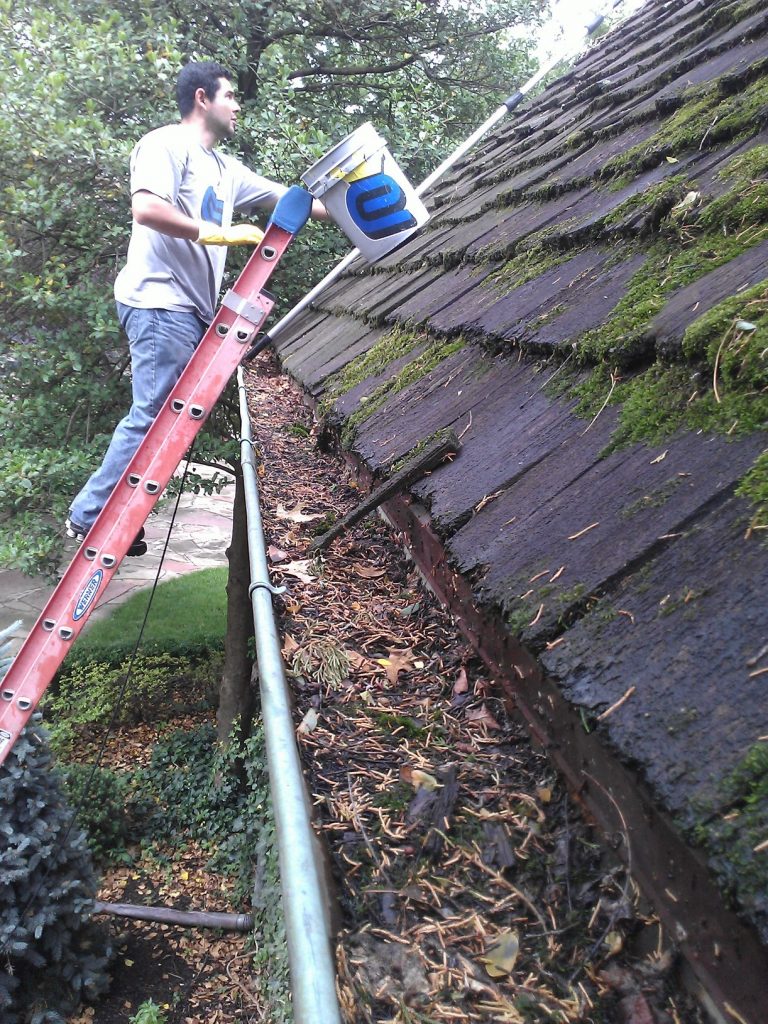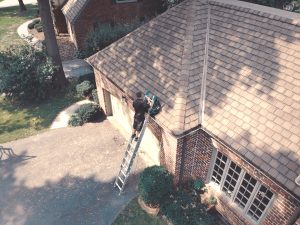How to Remove Roof Stains Without Expensive Chemicals
Your home’s roof is a workhorse, shielding you from the elements day in and day out. But over time, it can accumulate unsightly stains that not only detract from your home’s curb appeal but also indicate potentially damaging issues beneath the surface. Conventional wisdom might direct you towards a chemical-laden solution, but there are ways to restore your roof to its former glory without breaking the bank or harming the environment. In this comprehensive guide, we’ll explore the various types of roof stains, the non-chemical methods to combat them effectively, and why these approaches are beneficial for more than just your pocketbook.
The Importance of Roof Maintenance and the Impact of Stains
Regular roof maintenance is critical in extending the lifespan of your roofing materials and preventing costly repairs down the line. Stains on your roof, which may be due to algae, moss, or the accumulation of dirt and debris, are not solely an eyesore; they can also result in the deterioration of roofing materials. Over time, these stains can trap moisture, leading to rot and structural damage that compromises the integrity of your home. This can ultimately result in leaks and further damage if left untreated.
Moreover, certain types of stains can absorb heat, contributing to higher indoor temperatures and increased cooling costs. By addressing stains promptly and responsibly, homeowners can maintain not only the aesthetic appeal of their home but also its structural integrity while conserving energy.
To ensure the longevity of your roof, it is recommended to schedule regular inspections and cleanings, removing any stains or debris that may have accumulated. This proactive approach helps to safeguard your investment and minimize potential damage, saving you both time and money in the long run.

Common Types of Roof Stains
There are several common culprits behind roof discoloration, each with its own set of challenges and solutions:
- Algae: Often appearing as dark streaks or patches, algae is a frequent issue in humid climates and can quickly spread over roof surfaces. These stains are usually a blue-green hue and are particularly common on asphalt shingles.
- Moss: This green, fuzzy plant thrives in shaded, moist environments. Moss buildup can lift shingles, allowing water to penetrate and leading to potential leaks and wood rot.
- Lichen: A combination of algae and fungus, lichen is a hardy organism that forms a crust-like appearance on shingles, making it more difficult to remove without proper methods.
- Fungi and Mold: Usually resulting from persistent dampness, these can lead to black, green, or white patches, signaling excessive moisture and potential decay.
- Rust Stains: Commonly found near metal components of roofs, like chimneys or vents, when water interacts with the metal, it can create reddish-brown rust stains which can run down the roof.
- Dirt and Debris: Accumulation of leaves, branches, and dirt can cause stains, particularly in areas where water pools, leading to stagnant marks and growths on the roof’s surface.
Understanding the type of stain present is crucial in choosing the appropriate non-chemical cleaning method that will effectively remove the stain without damaging the roofing material.
Understanding the Causes
Understanding the causes behind roof stains is pivotal for choosing the right treatment strategy. In many cases, biological factors, such as algae and moss, feed on the limestone filler often used in asphalt shingles, gradually breaking down the integrity of the roofing material. Excessive shade and moisture, combined with minimal sunlight, create an ideal breeding ground for these organisms. Metal elements on the roof can oxidize and rust due to extended exposure to air and moisture, resulting in reddish-brown streaks that stain roofing materials.
Environmental debris, like leaves and branches, can retain moisture on the roof after rainstorms or morning dew, encouraging further growth of moss, lichen, and algae. Additionally, in areas with high air pollution or overhanging trees, particulate matter and tree sap can further contribute to stain buildup.
Natural weather events, such as windstorms, can lead to the accumulation of dirt and particulate matter that, over time, can cause additional discoloration. By recognizing these common causes, homeowners can take preventative measures to minimize roof stain development and ensure effective maintenance.
DIY Methods for Removing Roof Stains
If you’re facing the challenge of roof stains, you’ll be pleased to know that there are effective DIY methods for cleaning your roof that don’t rely on harsh chemicals. Before you begin, ensure you have the right safety equipment, such as a sturdy ladder, non-slip shoes, and protective gloves.
- Gentle Washing: Use a garden hose with a spray nozzle set to its gentlest setting to wash away loose debris. High-pressure washing can damage shingles and should be avoided.
- Homemade Cleaning Solutions: Create a mixture of equal parts water and white vinegar or a combination of water, non-bleach laundry detergent, and oxygen bleach as an environmentally friendly alternative to chemical cleaners. Apply with a pump sprayer and allow the solution to work on the stains for about an hour before rinsing thoroughly with water.
- Soft Bristle Brushing: For areas with moss or lichen, gently scrubbing with a soft bristle brush can help dislodge the growth. Focus on downward strokes to avoid lifting and damaging the shingles.
- Preventative Measures: Trim overhanging tree branches to reduce shade and minimize debris. Ensure proper attic ventilation and consider installing zinc or copper strips at the roof’s peak, which release metal ions during rain that help to prevent the growth of algae and moss.
By using these DIY methods, you can effectively remove unsightly stains from your roof while being mindful of both the environment and the longevity of your roofing materials. Remember to regularly inspect your roof for new stains and to address them promptly for long-term maintenance.

Benefits of Using Non-Chemical Solutions
Embracing non-chemical solutions for roof cleaning comes with a myriad of advantages that are not only kind to the environment but beneficial for the roof’s lifespan and homeowner safety:
- Eco-Friendliness: Avoiding harsh chemicals means less environmental impact, as runoff from the roof will not contaminate the surrounding soil or water supplies with toxins.
- Gentleness on Roofing Materials: Chemical cleaners can prematurely degrade roofing materials. Non-chemical approaches reduce wear and tear, extending the life of the roof.
- Safety for Plants and Animals: Chemicals can harm plants around your home and wildlife that come into contact with them. Non-chemical methods pose less risk to the local ecosystem.
- Cost-Effectiveness: Many non-chemical cleaners can be made from household items, offering a cost-saving alternative to commercial products.
- Health Considerations: By reducing the use of toxic substances, you also reduce the risk of adverse health effects that can occur from inhaling or handling harsh chemicals.
By focusing on non-chemical solutions for maintaining a clean roof, homeowners can enjoy these benefits while also upholding their responsibility to the planet and their own well-being.
Tips for Preventing Future Stains
Maintaining a stain-free roof requires a proactive approach to both prevention and regular maintenance. Here are some practical tips to keep in mind:
- Regular Inspections: Schedule biannual roof inspections to identify and address potential issues before they result in stains.
- Gutter Maintenance: Keep gutters clean and clear of debris to prevent water overflow, which can lead to staining.
- Proper Ventilation: Ensure your attic is well-ventilated to reduce moisture build-up, which can encourage the growth of mold and mildew.
- Moss and Algae Inhibitors: Install zinc or copper strips near the roof’s peak; these metals release ions that inhibit organic growth when it rains.
- Limit Shade Over the Roof: Trim trees and foliage to allow more sunlight onto the roof, which helps to keep it dry and limits the growth conditions for moss, algae, and lichen.
By taking a proactive approach, homeowners can effectively prevent future roof stains and ensure the longevity and aesthetic appeal of their home. With regular maintenance and environmentally friendly cleaning methods, you can keep your roof looking its best for years to come. Remember to always prioritize safety when working on your roof, and seek professional assistance if needed for more severe staining or damage. With these tips in mind, you can confidently maintain a clean and healthy roof for your home. So keep these tips in mind and happy cleaning!
Empire Window Cleaning
https://www.google.com/maps?cid=179019921911364350
435 Nichols Rd, Kansas City, MO 64112
(816) 739-5980
https://empirekc.com/





